As one might surmise from the name, Star Wars is fundamentally a story of conflict. As is the case with most such tales, the plot is driven primarily by two major opposing forces: the Galactic Empire and a certain ragtag band of rebel heroes (and, in the prequels, the Separatists and the Republic). Each side is represented onscreen by a cast of unique and memorable characters, but it is also worth noting that being unique and memorable does not necessarily equal being interesting, especially when we’re talking about the antagonists.
People will long remember Darth Maul, not for any clever characterization or witty dialogue (of all the main antagonists of the saga, he might have the least dialogue of any), but because he wielded a double-bladed lightsaber and had horns growing out of the top of his head. In fact, for all that the saga is trumpeted as the rise and fall and redemption of Anakin Skywalker, its approach to villains and their villainy is often ham-fisted at best and cringe-inducingly cartoonish at worst.
When the words “villain” and “Star Wars” appear in close proximity to each other, certain imagery is usually guaranteed to follow in the mind of the reader. Darth Vader, the sinister armored cyborg with the wheezing mechanical breathing. The insidious black-cloaked Emperor Palpatine, shriveled and elderly with sickly yellow eyes, lightning exploding from his fingertips to torture our intrepid hero.
Even Grand Moff Tarkin and the rest of the Imperial officer corps make up for what they lack in visible deformities with British accents (the language of choice for villains everywhere ever since Hollywood figured out how to make films with sound) and obviously Nazi-inspired attire. And, of course, the most obviously and unmistakably evil of all: Jabba the Hutt, the galaxy’s foremost crime lord, greed and gluttony incarnate in the form of a gargantuan, corpulent gastropod.
In Star Wars, villains are often rarely anything approaching subtle when it comes to carrying out their diabolical schemes. It’s not enough for them simply to commit horrific crimes, but they always take care to look the part while doing so, so that there will be absolutely no doubt in the audience’s mind that these are really Very Bad People who do Unpleasant Things.
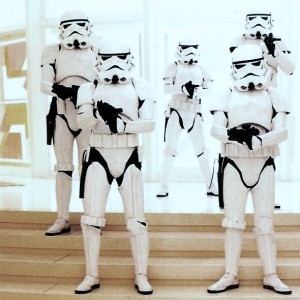
In the case of the Imperial stormtrooper, their faceless helmets and identical white body armor serve a twofold purpose, effectively dehumanizing them and making it considerably easier for audiences to accept our heroes mowing them down by the dozen in addition to fulfilling the need for the faceless legions of the Galactic Empire to be easily and immediately recognizable by viewers.
In concealing their faces and features, we strip them of any identifiable human features, and in general treat them as being little different from the lifeless battle droids of the Prequel Trilogy – who, incidentally, display far more personality and emotion than any Imperial stormtrooper was ever permitted.
When an antagonist takes the stage in Star Wars, it’s more as caricature than character. The Emperor is the image of the cackling evil overlord, tormenting our hero and attempting to lure him to something called “the dark side,” all while inciting him to commit patricide. Tarkin destroys our heroine’s entire homeworld – and one of the most important planets in the entire galaxy – killing untold billions of Imperial citizens in the process, simply because he can.
Jabba makes a living room centerpiece out of a frozen Han Solo for failing to pay his debts and claps Leia in a metal bikini and chains when he gets his slimy hands on her for kicks, and then proceeds to compound his manifold crimes by trying to feed our heroes to his hideous pet monstrosities (not once, but twice), again mostly for personal amusement. If there had been puppies or kittens present for any of this, one can be certain they’d have been swiftly kicked purely for sport.
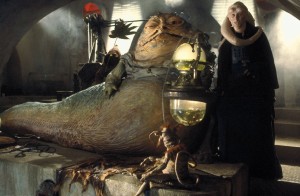
Far from taking a more nuanced approach than such exaggerated portrayals, the Prequel Trilogy seemed determined to come up with even more outlandish villains. The entire Neimoidian species is portrayed as cowardly and greedy to the last member, hiding behind a legion of spindly mindless battle droids while they lay siege to an entire planet at the bidding of a shadowy cowled figure. Darth Maul, tattooed an intimidating red and black, is no more than an extension of his master’s will, nearly as mindless as the aforementioned battle droids – a simple living weapon whose only purpose in the film is to menace our heroes.
It must be granted that the fallen Jedi and separatist leader Count Dooku was a vast improvement over his predecessors, but his tenure proved unfortunately brief when he was summarily dispatched at the beginning of Revenge of the Sith in favor of the entirely new and equally short-lived antagonist General Grievous, whose unsubtle villainy put Saturday morning cartoon villains to shame.
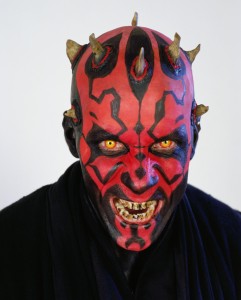
In all of these cases, Star Wars delivers the same clear messages: evil is obvious, and evil is absolute. Shades of gray are so rare as to be almost nonexistent: the closest the saga ever comes being Han shooting first, which was so infamously edited as to remove any potential traces of moral ambiguity from the side of good. The villains are so far removed from our heroes in terms of appearance that, simply looking at them, you could never even imagine them as being anything other than antagonists.
Anakin Skywalker’s tragic fall from hero to villain is accompanied by multiple amputations and his encasement in a suit of neo-medieval armor, while Luke Skywalker’s notably more heroic loss of a single hand is rapidly rectified by a sleek cybernetic replacement with a layer of synthetic skin that renders it completely indistinguishable from his old one. As demonstrated prominently by the Neimoidians, even entire species are divided into Good Aliens and Bad Aliens, with very few members of either ever crossing over to the other side.
As a throwback to the adventure serials that inspired its creation, Star Wars is undoubtedly faithful. However, when paying tribute to the tales of a bygone age, one must also take care not to fall into the trap of following blindly in the footsteps of works that may not just have fallen out of fashion, but have come to be considered outdated or no longer relevant in their way of thinking.
Once upon a time, comic book villains required little more than an absurd costume, an over-the-top evil scheme, and a maniacal laugh, and readers were content to see an endless parade of them thoroughly thrashed by various superheroes clad in equally embarrassing skintight costumes.
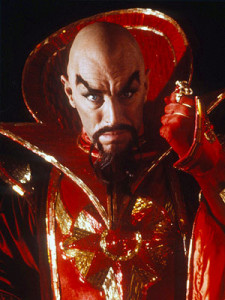
Over the years, the tastes of the readership have grown and changed, and now we expect and demand considerably more complexity from our villains that simply having them commit Evil Acts because they’re Evil People. Such a mentality is, quite rightfully, generally considered to be painfully outdated in its simplicity.
Once nearly unthinkable, even the most dedicated villain can be the protagonist of their own story without ever even having to consider a polar shift to the side of Good. We’re as interested in the beliefs and motivations of the opposition as we are our own side, and having our antagonists be as complex and varied in their characters as our heroes has become something worthy of praise.
Writers are almost more likely to explore the flaws in their own side than they are those of the enemy: authority figures and the government are no longer automatically assumed to be unassailable bastions of moral superiority and integrity, but rather a neutral entities as susceptible to corruption and rot as they are capable of good.
Given the nature and importance of the Republic’s transformation into the Empire, one could say that such musings are woven deeply into the fabric of the franchise itself, even if the Prequel Trilogy failed to thoroughly explore the implications, attributing the Republic’s downfall more to Sith manipulation than any irreparable internal failings.
When we’re willing to look at a conflict as being something more than just a story of Us vs. Them, the work and the audience are both better off for it. In doing so, we expand the range of tales available to us and give depth to both the villains and our heroes, liberating the latter from the necessity of remaining delicately balanced atop the pillar of moral superiority.
Complex characters, be they protagonist or antagonist, bring the galaxy more into line with our own world, where mustache-twirling supervillains are in notably short supply. Star Wars has already given us a six-film saga of absolute good and evil, and it seems doubtful that the Sequel Trilogy could craft villains any more loathsome and vile than those we have already seen without descending into self-parody.
Perhaps what the future calls for, then, is not to attempt to best the original films at their own themes, but to go down a different road entirely, and one that will better reflect the ways in which the world has changed since the release of A New Hope. Rather than yet more malevolent minions of the dark side, it might just be time for an antagonist whose motivations extend beyond “because they can.”
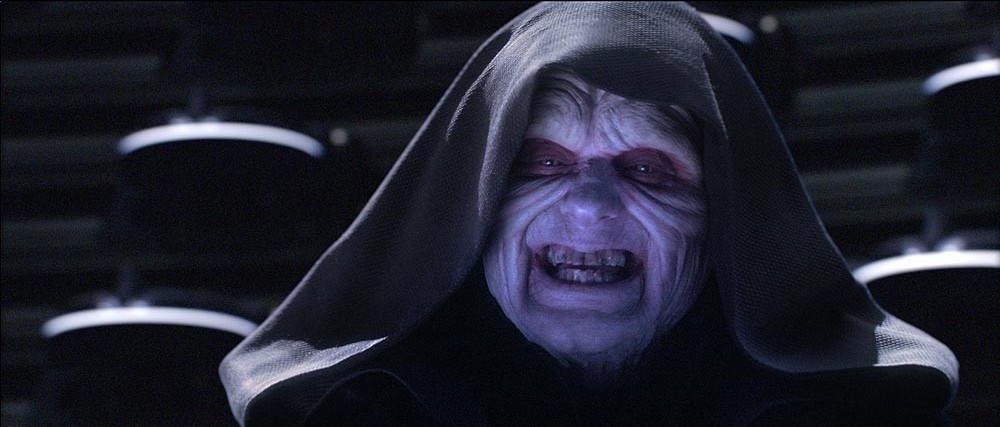

You fail to mention one of the strengths of the prequel trilogy, its depiction of evil not in the form of the cackling warlord but rather as the kindly old man who smiles and pats you on the back. As I have gotten older I have come to appreciate the fact that, when the bad guys do present themselves in my life, they tend to be smiling and friendly, like a certain Senator from Naboo. It would be a disservice to not recognize Lucas’ attempt to depict the more realistic nature of evil in Eps. 1-3.
Lando would also like a word with you about what happens in Ep 5 😉
Yep, adding a political operative operating in a democracy added more complexity and kept up with the times9politicians are increasingly unpopular).